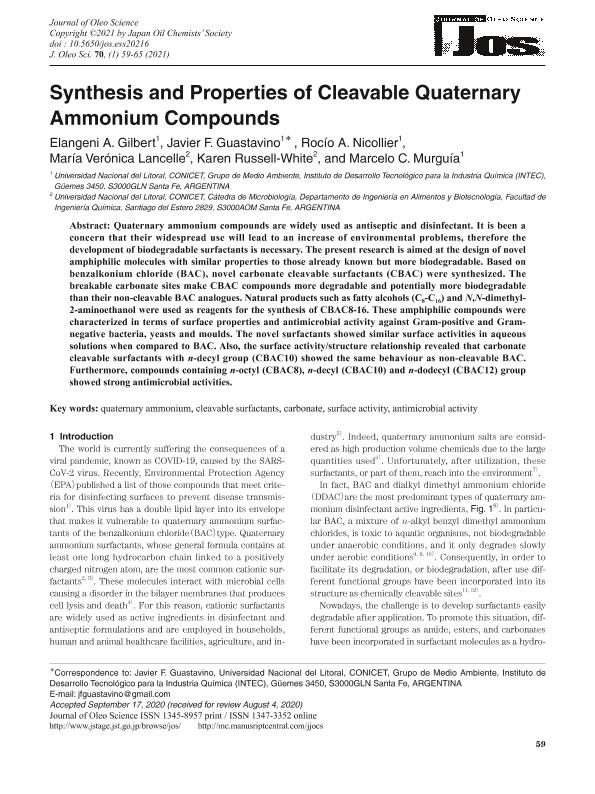Artículo
Synthesis and properties of cleavable quaternary ammonium compounds
Gilbert, Elangeni Ana ; Guastavino, Javier Fernando
; Guastavino, Javier Fernando ; Nicollier, Rocío A.; Lancelle, María Verónica; Russell White, Karen; Murguia, Marcelo Cesar
; Nicollier, Rocío A.; Lancelle, María Verónica; Russell White, Karen; Murguia, Marcelo Cesar
 ; Guastavino, Javier Fernando
; Guastavino, Javier Fernando ; Nicollier, Rocío A.; Lancelle, María Verónica; Russell White, Karen; Murguia, Marcelo Cesar
; Nicollier, Rocío A.; Lancelle, María Verónica; Russell White, Karen; Murguia, Marcelo Cesar
Fecha de publicación:
03/2021
Editorial:
Japan Oil Chemists’ Society
Revista:
Journal of Oleo Science
ISSN:
1345-8957
Idioma:
Inglés
Tipo de recurso:
Artículo publicado
Clasificación temática:
Resumen
Quaternary ammonium compounds are widely used as antiseptic and disinfectant. It is been a concern that their widespread use will lead to an increase of environmental problems, therefore the development of biodegradable surfactants is necessary. The present research is aimed at the design of novel amphiphilic molecules with similar properties to those already known but more biodegradable. Based on benzalkonium chloride (BAC), novel carbonate cleavable surfactants (CBAC) were synthesized. The breakable carbonate sites make CBAC compounds more degradable and potentially more biodegradable than their non-cleavable BAC analogues. Natural products such as fatty alcohols (C8-C16) and N,N-dimethyl- 2-aminoethanol were used as reagents for the synthesis of CBAC8-16. These amphiphilic compounds were characterized in terms of surface properties and antimicrobial activity against Gram-positive and Gramnegative bacteria, yeasts and moulds. The novel surfactants showed similar surface activities in aqueous solutions when compared to BAC. Also, the surface activity/structure relationship revealed that carbonate cleavable surfactants with n-decyl group (CBAC10) showed the same behaviour as non-cleavable BAC. Furthermore, compounds containing n-octyl (CBAC8), n-decyl (CBAC10) and n-dodecyl (CBAC12) group showed strong antimicrobial activities.
Archivos asociados
Licencia
Identificadores
Colecciones
Articulos(CCT - SANTA FE)
Articulos de CTRO.CIENTIFICO TECNOL.CONICET - SANTA FE
Articulos de CTRO.CIENTIFICO TECNOL.CONICET - SANTA FE
Citación
Gilbert, Elangeni Ana; Guastavino, Javier Fernando; Nicollier, Rocío A.; Lancelle, María Verónica; Russell White, Karen; et al.; Synthesis and properties of cleavable quaternary ammonium compounds; Japan Oil Chemists’ Society; Journal of Oleo Science; 70; 1; 3-2021; 59-65
Compartir
Altmétricas



